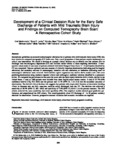Development of a Clinical Decision Rule for the Early Safe Discharge of Patients with Mild Traumatic Brain Injury and Findings on Computed Tomography Brain Scan: A Retrospective Cohort Study
| dc.contributor.author | Marincowitz, C | |
| dc.contributor.author | Lecky, FE | |
| dc.contributor.author | Allgar, Victoria | |
| dc.contributor.author | Hutchinson, P | |
| dc.contributor.author | Elbeltagi, H | |
| dc.contributor.author | Johnson, F | |
| dc.contributor.author | Quinn, E | |
| dc.contributor.author | Tarantino, S | |
| dc.contributor.author | Townend, W | |
| dc.contributor.author | Kolias, AG | |
| dc.contributor.author | Sheldon, TA | |
| dc.date.accessioned | 2021-08-09T11:21:21Z | |
| dc.date.available | 2021-08-09T11:21:21Z | |
| dc.date.issued | 2020-01-15 | |
| dc.identifier.issn | 0897-7151 | |
| dc.identifier.issn | 1557-9042 | |
| dc.identifier.uri | http://hdl.handle.net/10026.1/17470 | |
| dc.description.abstract |
International guidelines recommend routine hospital admission for all patients with mild traumatic brain injury (TBI) who have injuries on computed tomography (CT) brain scan. Only a small proportion of these patients require neurosurgical or critical care intervention. We aimed to develop an accurate clinical decision rule to identify low-risk patients safe for discharge from the emergency department (ED) and facilitate earlier referral of those requiring intervention. A retrospective cohort study of case notes of patients admitted with initial Glasgow Coma Scale 13-15 and injuries identified by CT was completed. Data on a primary outcome measure of clinically important deterioration (indicating need for hospital admission) and secondary outcome of neurosurgery, intensive care unit admission, or intubation (indicating need for neurosurgical admission) were collected. Multi-variable logistic regression was used to derive models and a risk score predicting deterioration using routinely reported clinical and radiological candidate variables identified in a systematic review. We compared the performance of this new risk score with the Brain Injury Guideline (BIG) criteria, derived in the United States. A total of 1699 patients were included from three English major trauma centers. A total of 27.7% (95% confidence interval [CI], 25.5-29.9) met the primary and 13.1% (95% CI, 11.6-14.8) met the secondary outcomes of deterioration. The derived clinical decision rule suggests that patients with simple skull fractures or intracranial bleeding <5 mm in diameter who are fully conscious could be safely discharged from the ED. The decision rule achieved a sensitivity of 99.5% (95% CI, 98.1-99.9) and specificity of 7.4% (95% CI, 6.0-9.1) to the primary outcome. The BIG criteria achieved the same sensitivity, but lower specificity (5%). Our empirical models showed good predictive performance and outperformed the BIG criteria. This would potentially allow ED discharge of 1 in 20 patients currently admitted for observation. However, prospective external validation and economic evaluation are required. | |
| dc.format.extent | 324-333 | |
| dc.format.medium | Print-Electronic | |
| dc.language | en | |
| dc.language.iso | eng | |
| dc.publisher | Mary Ann Liebert Inc | |
| dc.subject | intracranial hemorrhage | |
| dc.subject | mild traumatic brain injury | |
| dc.subject | minor head injury | |
| dc.subject | prognostic modeling | |
| dc.title | Development of a Clinical Decision Rule for the Early Safe Discharge of Patients with Mild Traumatic Brain Injury and Findings on Computed Tomography Brain Scan: A Retrospective Cohort Study | |
| dc.type | journal-article | |
| dc.type | Journal Article | |
| dc.type | Research Support, Non-U.S. Gov't | |
| plymouth.author-url | https://www.webofscience.com/api/gateway?GWVersion=2&SrcApp=PARTNER_APP&SrcAuth=LinksAMR&KeyUT=WOS:000495445200001&DestLinkType=FullRecord&DestApp=ALL_WOS&UsrCustomerID=11bb513d99f797142bcfeffcc58ea008 | |
| plymouth.issue | 2 | |
| plymouth.volume | 37 | |
| plymouth.publication-status | Published | |
| plymouth.journal | Journal of Neurotrauma | |
| dc.identifier.doi | 10.1089/neu.2019.6652 | |
| plymouth.organisational-group | /Plymouth | |
| plymouth.organisational-group | /Plymouth/Faculty of Health | |
| plymouth.organisational-group | /Plymouth/Faculty of Health/Peninsula Medical School | |
| plymouth.organisational-group | /Plymouth/REF 2021 Researchers by UoA | |
| plymouth.organisational-group | /Plymouth/REF 2021 Researchers by UoA/UoA01 Clinical Medicine | |
| plymouth.organisational-group | /Plymouth/Research Groups | |
| plymouth.organisational-group | /Plymouth/Research Groups/Plymouth Institute of Health and Care Research (PIHR) | |
| plymouth.organisational-group | /Plymouth/Users by role | |
| plymouth.organisational-group | /Plymouth/Users by role/Academics | |
| dc.publisher.place | United States | |
| dc.identifier.eissn | 1557-9042 | |
| dc.rights.embargoperiod | Not known | |
| rioxxterms.versionofrecord | 10.1089/neu.2019.6652 | |
| rioxxterms.licenseref.uri | http://www.rioxx.net/licenses/all-rights-reserved | |
| rioxxterms.type | Journal Article/Review |


